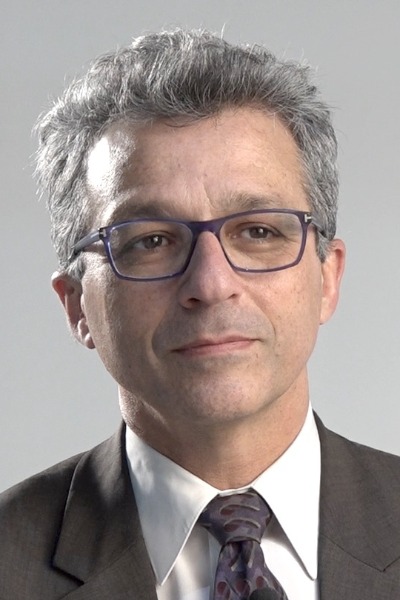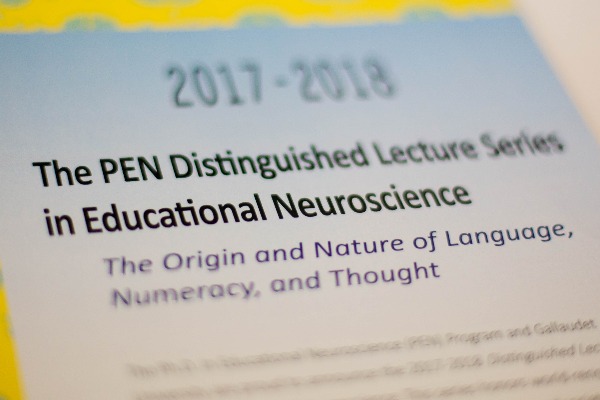PEN Distinguished Lecture Series
The PEN Distinguished Lecture Series in Educational Neuroscience was created in association with the Foundations Proseminar course for graduate students in the Ph.D. in Educational Neuroscience (PEN) program. Since its inception, the series has grown!
The lecture series focuses on the intersection of the Science of Learning (learning across the lifespan) and Educational Neuroscience (learning across early life). Scientists and researchers who are pioneers in the fields of Cognitive-Educational Neuroscience, Developmental Cognitive Neuroscience, and Child Development come to Gallaudet University's campus to talk about their research.
Register for Upcoming Lectures
All lectures are open to the public and are video recorded for online distribution.
PEN DLS brochure for 2024-2025
Educating for brain health and humanity

Abstract
The human brain is made up of neurones, highly sophisticated and stable cellular structures. However, neurones are engaged in dynamically changing networks that provide a most energy efficient, spatially compact, and precise means to process input signals and generate adaptable responses to a changing environment.
Plasticity is an intrinsic property of such networks, and may be best conceptualized as evolution’s invention to enable the nervous system to escape the restrictions of its own genome (and its highly specialized cellular specification), and thus adapt to environmental pressures, physiologic changes, and experiences.
Consider the challenges faced by a musician. Playing a musical instrument, requires more than factual knowledge about the musical instrument and about the mechanics of how it is played.
The central nervous system has to acquire and implement a “translation mechanism” to convert knowledge into action. These translation capabilities, acquired over years of practice, result in changes in the organization of the brain.
Initially, while learning a musical instrument (as indeed while acquiring any other skill) rapid changes take place in the brain, that probably represent the unmasking and activation of existing pathways.
Eventually, over months and years of sustained practice, more stable, structural changes appear to take place.
Beyond such learning-related brain changes, the brain also changes across the lifespan in response to environmental influences, life events, experiences, changes in sensory inputs, aging-related neurobiological changes, disease or injury, etc.
At the same time, the mechanisms of plasticity and the resulting brain dynamics vary, as indeed they vary across individuals and are modified by genetic predispositions, environmental influences, life experiences, age, insult or disease. Innovative experimental paradigms can assess cortical plasticity in humans, in vivo, across the lifespan, and offer translatable biomarkers that can bridge the gap between animal models and humans.
Ultimately, changes in brain plasticity and dynamics may proof maladaptive and lead to disease. Aberrant, excessive or insufficient, or mistimed plasticity may represent the proximal pathogenic cause of neurodevelopmental and neurodegenerative disorders such as autism spectrum disorders, schizophrenia, or Alzheimer’s disease.
On the other hand, optimizing activity within and across brain networks can promote brain health, sustain cognitive function and well-being across the life-span, and leverage the impact of brain function on overall health (salutogenesis).
Learning objectives:
1. Explain the concept of plasticity as a life-long intrinsic property of the human brain.
2. Describe mechanisms of plasticity
3. Learn about methods to assess the mechanisms of plasticity in humans.
4. Discuss implications of brain plasticity for brain health and lifelong well-being.
Biography
Dr. Alvaro Pascual-Leone is a Professor of Neurology and Director of the Berenson-Allen Center for Noninvasive Brain Stimulation at Beth Israel Deaconess Medical Center and Harvard Medical School, where he also serves as Program Director of the Harvard-Thorndike Clinical Research Center.
His research aims at understanding the mechanisms that control brain plasticity across the lifespan to be able to modify them for the subject’s optimal behavioral outcome.
Pascual-Leone combines various brain imaging and brain stimulation methodologies to establish a causal relationship and a precise chronometry between regional brain activation and behavior, and uses noninvasive brain stimulation techniques to modulate brain plasticity, suppressing some changes and enhancing others, to gain a clinical benefit and behavioral advantage for a given individual.
Such non-invasive approaches can lead to clinically relevant therapeutic effects in neuropsychiatry and neurorehabilitation, and serve as proof-of-principle prior to more invasive neuromodulatory interventions. A major interest of current work aims at translating insights from cognitive neuroscience into clinical interventions.
